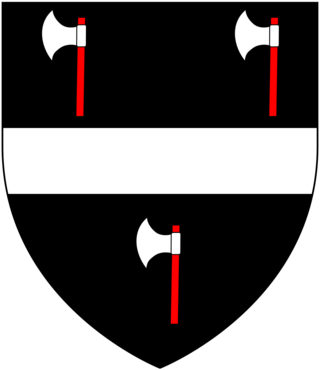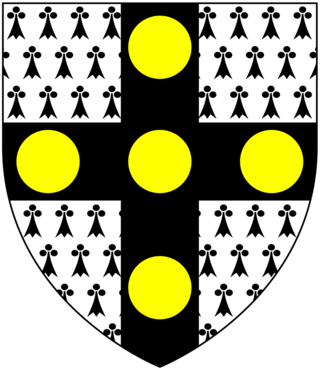
Earl of Lonsdale is a title that has been created twice in British history, firstly in the Peerage of Great Britain in 1784, and then in the Peerage of the United Kingdom in 1807, both times for members of the Lowther family.

Baron St Levan, of St Michael's Mount in the County of Cornwall, is a title in the Peerage of the United Kingdom. It was created on 4 July 1887 for the former Member of Parliament Sir John St Aubyn, 2nd Baronet, becoming John St Aubyn, 1st Baron St Levan. He had previously represented Cornwall West in House of Commons as a Liberal and St Ives as a Liberal Unionist. He was succeeded by his eldest son, the second Baron, who was a Colonel and Honorary Brigadier-General in the Grenadier Guards. On his death the titles passed to his nephew, the third Baron, the son of the Hon. Sir Arthur James Dudley Stuart St Aubyn (1867–1897), second son of the first Baron. The third baron was succeeded in 1978 by his eldest son, the fourth baron, who had served with the Royal Navy at Dunkirk and in a minesweeper in Arctic Convoys during World War II and was awarded the Distinguished Service Cross (DSC). As of 2014, the titles are held by the fourth Baron's nephew, the fifth Baron, who succeeded in 2013.

There have been seven baronetcies created for members of the Lowther family, one in the Baronetage of Nova Scotia, two in the Baronetage of England, two in the Baronetage of Great Britain and two in the Baronetage of the United Kingdom. Two of the creations are extant as of 2008.

There have been three baronetcies created for persons with the surname Croft, one in the Baronetage of England and two in the Baronetage of the United Kingdom. All three creations are extant as of 2008.
There have been two baronetcies created for people with the surname Heathcote, both in the Baronetage of Great Britain and both created in 1733. The holders of the first creation were later elevated to the peerage as Baron Aveland and Earl of Ancaster, which titles are now extinct. However, both baronetcies are extant as of 2008.

There have been four baronetcies created for persons with the surname Sykes, two in the Baronetage of Great Britain and two in the Baronetage of the United Kingdom. Three of the creations are extant as of 2008.
John St Aubyn, 1st Baron St Levan, known as Sir John St Aubyn, 2nd Baronet, from 1872 to 1887, was a British Liberal, and later Liberal Unionist, politician who sat in the House of Commons from 1858 until 1887 when he was raised to the peerage.

There have been four baronetcies created for persons with the surname Hope, three in the Baronetage of Nova Scotia and one in the Baronetage of the United Kingdom. As of 2010 one creation is extant, one dormant and two extinct.

The Wrey Baronetcy, of Trebitch in the County of Cornwall, is a title in the Baronetage of England. It was created on 30 June 1628 for William Wrey (d.1636), 2nd son of John Wrey of Trebeigh, St Ive, Cornwall, a member of an ancient Devon family. The third Baronet was a supporter of the Royalist cause and sat as Member of Parliament for Lostwithiel after the Restoration. He married Lady Anne, third daughter and co-heir of Edward Bourchier, 4th Earl of Bath, and a co-heir to the barony of Fitzwarine. The fourth Baronet represented Liskeard and Devon in the House of Commons. The fifth Baronet was Member of Parliament for Camelford while the sixth Baronet represented Barnstaple.

The Trelawny, later Salusbury-Trelawny Baronetcy, of Trelawny in the County of Cornwall, is a title in the Baronetage of England. It was created on 1 July 1628 for John Trelawny of Trelawny in the parish of Pelynt in Cornwall. The family derived much of their political power from their patronage of the nearby pocket borough of East Looe. The second Baronet sat as Member of Parliament for East Looe, Cornwall and Liskeard. The third Baronet was a clergyman and one of the Seven Bishops imprisoned by James II. The fourth Baronet represented West Looe, Liskeard and East Looe in the House of Commons. The fifth Baronet was Member of Parliament for East Looe. The sixth Baronet sat as Member of Parliament for West Looe and served as Governor of Jamaica. The eighth Baronet was Member of Parliament for East Cornwall 1832–1837 and Lord-Lieutenant of Cornwall. In 1802 he assumed the additional surname of Salusbury. The ninth Baronet represented Tavistock and East Cornwall in Parliament.

There have been two baronetcies created for members of the St Aubyn family, one in the Baronetage of England and one in the Baronetage of the United Kingdom.
The Vyvyan Baronetcy of Trelowarren, Cornwall is a title in the Baronetage of England. It was created on 12 February 1645 for Richard Vyvyan, a member of Parliament for Penrhyn, Tregony and St Mawes and Master of the Mint. His eldest son, the second Baronet, represented St Mawes and Helston in the House of Commons. He was succeeded in 1697 by his son, the third Baronet, was a member of Parliament for Mitchell and Cornwall and a prominent Jacobite. The eighth Baronet sat as Conservative Member of Parliament for Cornwall, Okehampton, Bristol and Helston. His grandson, the tenth Baronet, was a Colonel in the British Army. As of 28 February 2014, the present Baronet has not successfully proven his succession and is therefore not on the Official Roll of the Baronetage, with the baronetcy considered dormant since 1995.
There have been four baronetcies created for members of the Thorold family of Lincolnshire, two in the Baronetage of England and two in the Baronetage of Great Britain. As of 2014 one creation is extant.
There have been two baronetcies created for persons with the surname Ramsden, one in the Baronetage of England and one in the Baronetage of the United Kingdom. One creation is extant as of 2008

There have been three baronetcies created for persons with the surname Carew, two in the Baronetage of England prior to 1707, one in the Baronetage of Great Britain.

Sir William Molesworth, 6th Baronet was one of the Molesworth baronets of Pencarrow, Cornwall and a British politician who sat in the House of Commons from 1784 and 1790.
William Napleton Molesworth-St Aubyn was an English Conservative politician who sat in the House of Commons from 1880 to 1885.

Sir Lewis William Molesworth Bt. was an English landowner from Cornwall and Liberal Unionist Party politician.

Catherine St Aubyn (1760–1836) was a Cornish amateur artist.

Sir John Molesworth, 4th Baronet (1705–1766) of Pencarrow, Cornwall, was a British landowner and Tory politician who sat in the House of Commons between 1734 and 1761.














